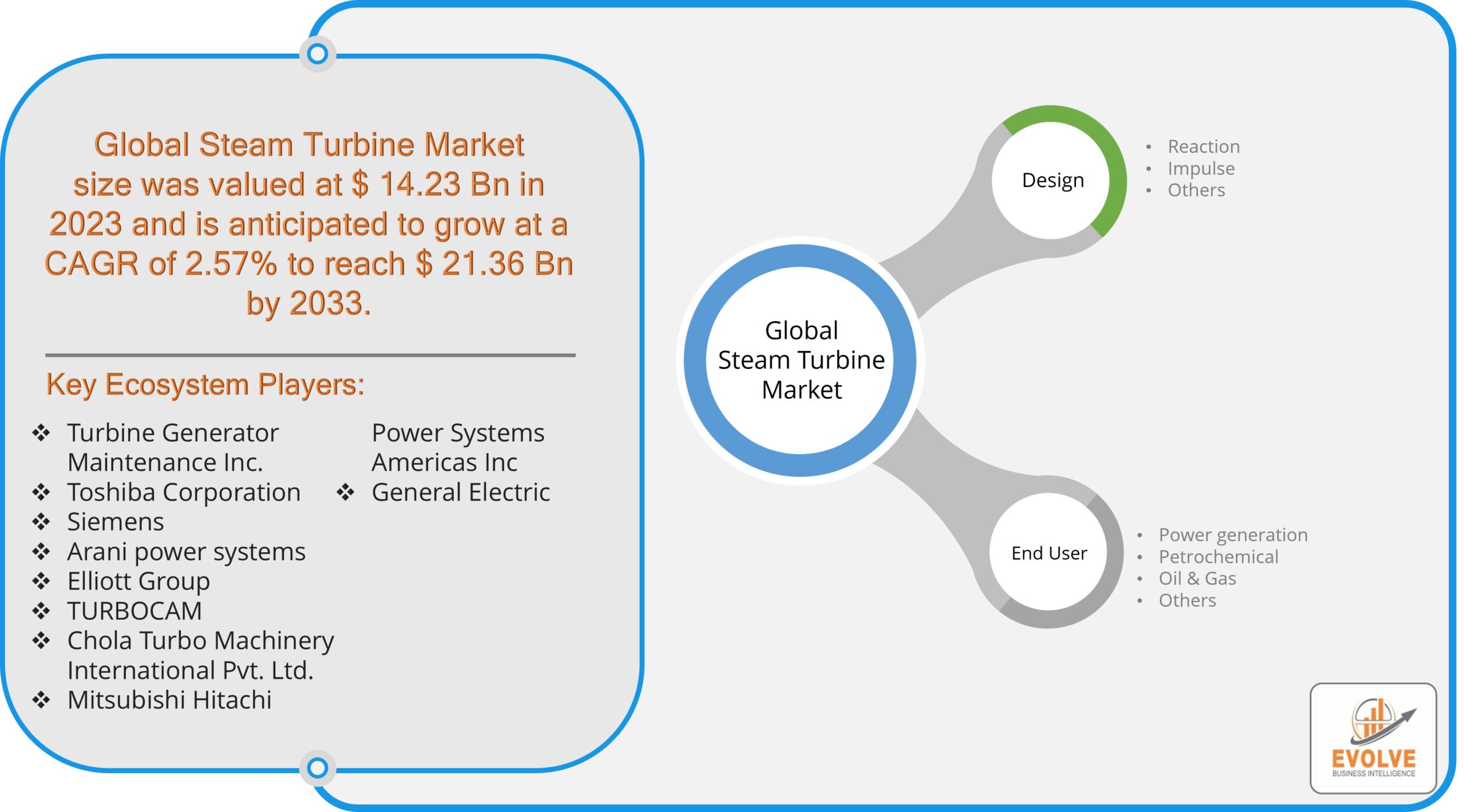Steam Turbine Market Is Estimated To Record a CAGR of Around 2.57%

Evolve Business Intelligence has published a research report on the Global Steam Turbine Market, 2023–2033. The global Steam Turbine market is projected to exhibit a CAGR of around 2.57%during the forecast period of 2023 to 2033.
Evolve Business Intelligence has recognized the following companies as the key players in the global Steam Turbine Market: Turbine Generator Maintenance Inc., Toshiba Corporation, Siemens, Arani power systems, Elliott Group, TURBOCAM, Chola Turbo Machinery International Pvt. Ltd., Mitsubishi Hitachi Power Systems Americas Inc, General Electric.
For More Information: https://evolvebi.com/report/steam-turbine-market-analysis/
Global Steam Turbine Market Highlights
The Global Steam Turbine market is projected to be valued at USD 21.36 Billion by 2033, recording a CAGR of around 2.57% during the forecast period. The steam turbine market encompasses the global industry involved in the production, distribution, and maintenance of steam turbines, which are critical components in power generation, industrial applications, and marine propulsion. Steam turbines convert thermal energy from steam into mechanical energy, which is then used to generate electricity or drive machinery. The market is driven by the demand for energy efficiency, renewable energy integration, and advancements in turbine technology. Key sectors include power plants, refineries, and chemical plants. Regional market dynamics vary, with Asia-Pacific being a significant growth region due to industrialization and energy needs.
The COVID-19 pandemic has caused supply chain hiccups, which have decreased demand or created shortages in the steam turbine sector. Spending by consumers and businesses has decreased significantly as a result of the travel restrictions and social distancing measures, and this trend is expected to persist for some time. The epidemic has altered end-user trends and tastes, leading manufacturers, developers, and service providers to implement several measures in an attempt to stabilize their businesses.
Segmental Analysis
The global Steam Turbine market has been segmented based on Design, End User
Based on Design, the market is segmented into Reaction, and Impulse, among others. The impulse steam turbines segment dominates the market due to their simpler design, efficiency at converting high-pressure steam into mechanical energy, and widespread use in power generation and various industrial applications.
Based on End Users, the market has been divided into Power Generation, Petrochemical, and Oil & Gas, among others. The power generation segment dominates the steam turbine market, as steam turbines are crucial for large-scale electricity production in both traditional fossil fuel and nuclear power plants, as well as in renewable energy applications like biomass and concentrated solar power.
For More Information: https://evolvebi.com/report/steam-turbine-market-analysis/
Regional Analysis
The Steam Turbine market is divided into five regions: North America, Europe, Asia-Pacific, South America, and the Middle East, &Africa. North America holds a dominant position in the Steam Turbine Market. In North America, the steam turbine market is driven by the need for efficient and reliable power generation infrastructure. The region’s focus on upgrading aging power plants, coupled with investments in renewable energy projects such as biomass and concentrated solar power, supports market growth. Technological advancements and stringent environmental regulations also drive demand for modern, high-efficiency steam turbines. The presence of major industry players and ongoing industrial activities further contribute to the market’s development in this region.
The Asia-Pacific region has indeed emerged as the fastest-growing market for the Steam Turbine industry. The steam turbine market in Asia-Pacific is experiencing significant growth due to rapid industrialization, urbanization, and increasing energy demand in countries like China and India. Investments in power generation infrastructure, including coal, nuclear, and renewable energy projects, are driving market expansion. Government initiatives to enhance energy efficiency and reduce emissions are also promoting the adoption of advanced steam turbine technologies. Additionally, the region’s large-scale industrial activities and ongoing infrastructure development create a robust market environment for steam turbines.


